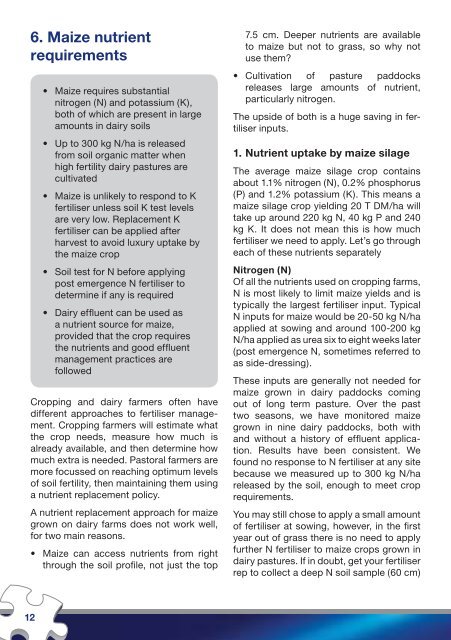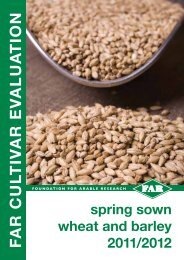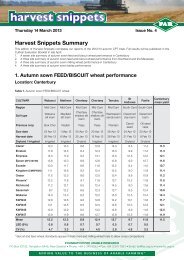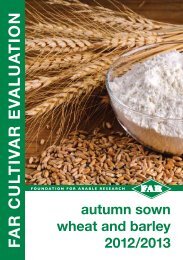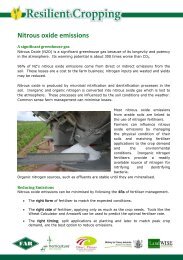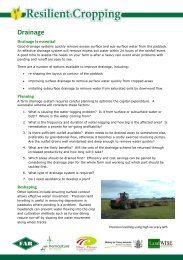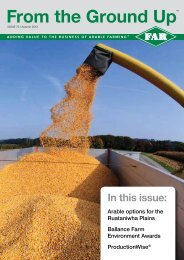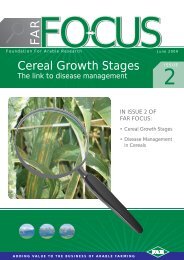Best Management Practices for Growing Maize on Dairy Farms
Best Management Practices for Growing Maize on Dairy Farms
Best Management Practices for Growing Maize on Dairy Farms
- No tags were found...
You also want an ePaper? Increase the reach of your titles
YUMPU automatically turns print PDFs into web optimized ePapers that Google loves.
6. <str<strong>on</strong>g>Maize</str<strong>on</strong>g> nutrientrequirements• <str<strong>on</strong>g>Maize</str<strong>on</strong>g> requires substantialnitrogen (N) and potassium (K),both of which are present in largeamounts in dairy soils• Up to 300 kg N/ha is releasedfrom soil organic matter whenhigh fertility dairy pastures arecultivated• <str<strong>on</strong>g>Maize</str<strong>on</strong>g> is unlikely to resp<strong>on</strong>d to Kfertiliser unless soil K test levelsare very low. Replacement Kfertiliser can be applied afterharvest to avoid luxury uptake bythe maize crop• Soil test <str<strong>on</strong>g>for</str<strong>on</strong>g> N be<str<strong>on</strong>g>for</str<strong>on</strong>g>e applyingpost emergence N fertiliser todetermine if any is required• <strong>Dairy</strong> effluent can be used asa nutrient source <str<strong>on</strong>g>for</str<strong>on</strong>g> maize,provided that the crop requiresthe nutrients and good effluentmanagement practices arefollowedCropping and dairy farmers often havedifferent approaches to fertiliser management.Cropping farmers will estimate whatthe crop needs, measure how much isalready available, and then determine howmuch extra is needed. Pastoral farmers aremore focussed <strong>on</strong> reaching optimum levelsof soil fertility, then maintaining them usinga nutrient replacement policy.A nutrient replacement approach <str<strong>on</strong>g>for</str<strong>on</strong>g> maizegrown <strong>on</strong> dairy farms does not work well,<str<strong>on</strong>g>for</str<strong>on</strong>g> two main reas<strong>on</strong>s.• <str<strong>on</strong>g>Maize</str<strong>on</strong>g> can access nutrients from rightthrough the soil profile, not just the top7.5 cm. Deeper nutrients are availableto maize but not to grass, so why notuse them?• Cultivati<strong>on</strong> of pasture paddocksreleases large amounts of nutrient,particularly nitrogen.The upside of both is a huge saving in fertiliserinputs.1. Nutrient uptake by maize silageThe average maize silage crop c<strong>on</strong>tainsabout 1.1% nitrogen (N), 0.2% phosphorus(P) and 1.2% potassium (K). This means amaize silage crop yielding 20 T DM/ha willtake up around 220 kg N, 40 kg P and 240kg K. It does not mean this is how muchfertiliser we need to apply. Let’s go througheach of these nutrients separatelyNitrogen (N)Of all the nutrients used <strong>on</strong> cropping farms,N is most likely to limit maize yields and istypically the largest fertiliser input. TypicalN inputs <str<strong>on</strong>g>for</str<strong>on</strong>g> maize would be 20-50 kg N/haapplied at sowing and around 100-200 kgN/ha applied as urea six to eight weeks later(post emergence N, sometimes referred toas side-dressing).These inputs are generally not needed <str<strong>on</strong>g>for</str<strong>on</strong>g>maize grown in dairy paddocks comingout of l<strong>on</strong>g term pasture. Over the pasttwo seas<strong>on</strong>s, we have m<strong>on</strong>itored maizegrown in nine dairy paddocks, both withand without a history of effluent applicati<strong>on</strong>.Results have been c<strong>on</strong>sistent. Wefound no resp<strong>on</strong>se to N fertiliser at any sitebecause we measured up to 300 kg N/hareleased by the soil, enough to meet croprequirements.You may still chose to apply a small amountof fertiliser at sowing, however, in the firstyear out of grass there is no need to applyfurther N fertiliser to maize crops grown indairy pastures. If in doubt, get your fertiliserrep to collect a deep N soil sample (60 cm)12


